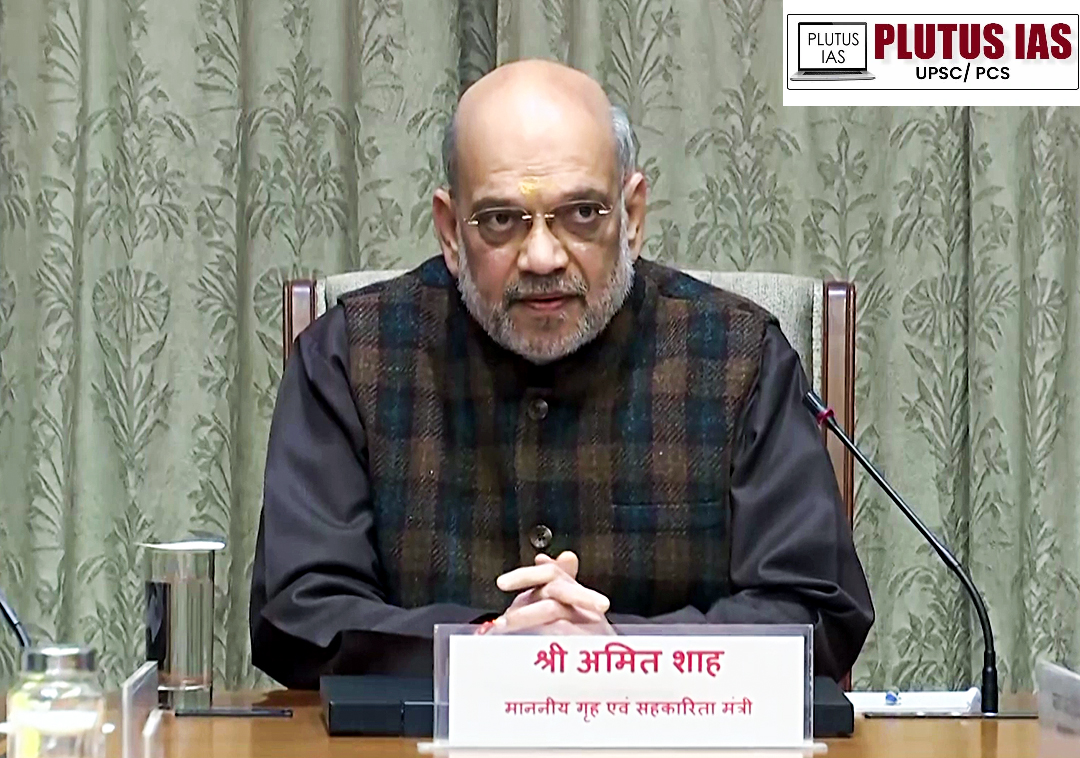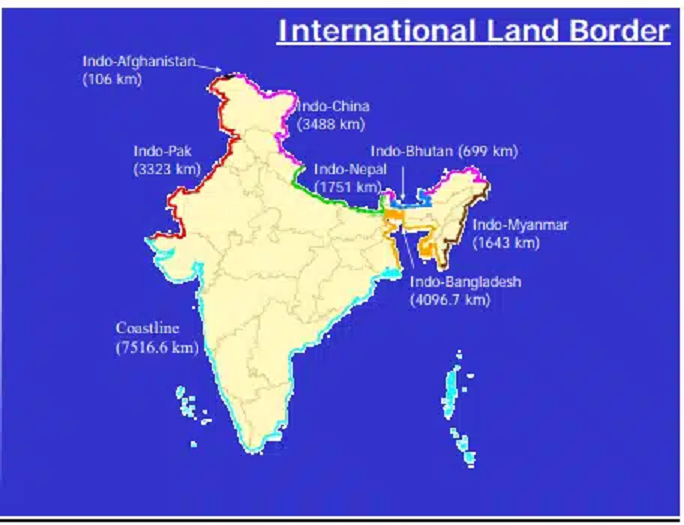01 Mar Security in Border Areas
This article covers “Daily Current Affairs” and Topic details Security in border Areas.
SYLLABUS MAPPING:
GS-3-Internal Security- Security in Border Areas
FOR PRELIMS
What is an Aspirational district Programme operations Sadhbhavana, Other initiatives in border area development
FOR MAINS
Why in the news?
Home Minister Amit Shah has directed authorities to dismantle networks facilitating the illegal entry, documentation, and settlement of Bangladeshi and Rohingya intruders, citing national security concerns. In a high-level meeting with Delhi’s newly elected Chief Minister Rekha Gupta, Shah emphasized strict action against these networks and underperforming police stations. He also called for a crackdown on interstate gangs and narcotics, the appointment of special prosecutors for the 2020 Delhi riots cases, and an expedited police recruitment process. Additionally, he urged DCP-level officers to engage with the public to address grievances. These directives aim to strengthen law enforcement and national security in Delhi.

India and land border:
India shares a 15,106.7 km land border and a 7,516.6 km coastline, including island territories. The land borders with neighbouring countries are as follows:
Bangladesh: 4,096.7 km
China: 3,488 km
Pakistan: 3,323 km
Nepal: 1,751 km
Myanmar: 1,643 km
Bhutan: 699 km
Afghanistan: 106 km
In January 2004, the Ministry of Home Affairs created the Department of Border Management to focus on securing international land and coastal borders. Its responsibilities include strengthening border policing, infrastructure creation like roads and fencing, and implementing the Border Area Development Programme. The department also oversees the construction of 13 Integrated Check Posts (ICPs) and the establishment of the Land Ports Authority of India (LPAI).
Key initiatives by the Department of Border Management include:
Expedited construction of fencing, floodlighting, and roads along the Indo-Bangladesh, Indo-Pakistan, and Indo-Myanmar borders.
Strategic roads along the India-China, Indo-Nepal, and Indo-Bhutan borders.
Deployment of high-tech surveillance equipment along international borders.
Construction of 509 Border Out Posts (BOPs) for the BSF.
Implementation of Coastal Security Schemes.
Development of Integrated Check Posts (ICPs) and management through LPAI.

Threat to National Security in land border areas
1. Cross-border terrorism: Militant groups operating across borders pose a significant threat, infiltrating and conducting attacks, often with the support or tolerance of neighbouring countries.
2. Illegal immigration: Porous borders allow large-scale illegal entry, potentially changing demographics, straining public services, and fueling social tensions.
3. Smuggling activities: Poorly monitored borders facilitate the trafficking of drugs, arms, and other illicit goods, empowering criminal networks and threatening national security.
4. Espionage and intelligence gathering: Border regions can be exploited by hostile actors to gather sensitive information, threatening national security by compromising military and political secrets.
5. Border disputes: Unresolved territorial claims lead to diplomatic tensions, sometimes escalating into military confrontations, especially in contested border regions.
6. Terrain challenges: Geographical features like mountains, forests, and rivers make border surveillance and patrolling difficult, creating gaps in security coverage.
7. Lack of infrastructure: Insufficient infrastructure—such as roads, surveillance technology, and border posts—leaves borders vulnerable to breaches, delays in response, and difficulties in monitoring.
Govt. Initiatives to protect land borders
1. Infrastructure Development:
Fencing & Floodlighting: Implemented on critical borders like India-Pakistan and India-Bangladesh.
Border Roads & Posts: Construction of roads and Border Outposts (BOPs) for better surveillance and troop mobility, e.g., the Trans-Arunachal Highway.
Vibrant Villages Programme: Development of villages along the LAC to prevent insurgent support.
2. Technology Integration:
CIBMS: Integration of sensors, surveillance, and command systems for real-time border monitoring.
UAVs/Drones: Deployed for surveillance and infiltration monitoring, especially on sensitive borders.
3. Development Programs:
Border Area Development Programme (BADP): Focus on infrastructure, healthcare, education, and skill development for border populations.
Coastal Security Scheme (CSS): Enhances maritime security with vessel tracking biometric IDs for fishermen.
4. Bilateral Cooperation:
Strengthening cooperation with neighbouring countries through joint working groups and national-level meetings to manage border-related issues.
Challenges in the handling of land border security
1. Porous Borders: Particularly with Nepal, Bhutan, Myanmar, and Bangladesh, allowing illegal immigration, infiltration, and smuggling.
2. Difficult Terrain: Mountainous, forested, and riverine areas complicate monitoring and security operations.
3. Shortage of Manpower: Over 83,000 vacancies in border guarding forces make it difficult to secure borders effectively.
4. Inadequate Infrastructure: Limited mobility and logistics, especially in forward areas.
5. Cross-border Terrorism & Insurgency: Terrorist infiltration and insurgent sanctuaries in neighbouring countries pose security threats.
6. Coordination Issues: Multiple agencies are involved, leading to command and control challenges.
Recommendation by committees
1. GoM (2001): Creation of the Department of Border Management, better coordination, and integrated check posts (ICPs).
2. Kargil Review Committee (1999): Improved infrastructure and coordination between military and paramilitary forces.
3. BSF Reports: Focus on enhanced fencing, floodlighting, and modern surveillance.
4. Nirmal Committee (2015): Expedited border road and surveillance infrastructure development.
5. NSAB Recommendations: Creation of a National Border Security Agency (NBSA) and improved intelligence sharing.
6. Standing Committee on Home Affairs (2018): Recommended manpower increase and improved surveillance along Indo-China borders.
Conclusion
India’s land border security is crucial due to challenges like cross-border terrorism, illegal immigration, smuggling, espionage, and unresolved territorial disputes. The Department of Border Management has initiated key measures, such as fencing, road construction, and advanced surveillance systems (CIBMS, UAVs). However, issues like porous borders, difficult terrain, manpower shortages, and inadequate infrastructure persist. Committees like the GoM (2001) and Kargil Review Committee (1999) have recommended better coordination, enhanced infrastructure, and manpower. Home Minister Amit Shah’s recent directives focus on addressing illegal immigration and strengthening law enforcement. Ongoing infrastructure development, technological integration, and cooperation with neighbouring countries are vital for securing India’s borders and national security.
Download Plutus IAS Current Affairs (Eng) 1 March 2025
Prelims Questions:
Q.With reference to the Department of Border Management and its initiatives to secure India’s land borders, which of the following statements is/are correct?
1. The Department of Border Management was created by the Ministry of Home Affairs in 2004.
2. The Department is responsible for constructing Integrated Check Posts (ICPs) along international borders.
Select the correct answer using the code given below:
A. 1 only
B. 2 only
C. Both 1 and 2
D. Neither 1 nor 2
Answer: C
Mains Questions:
(250 words, 15 marks)




No Comments